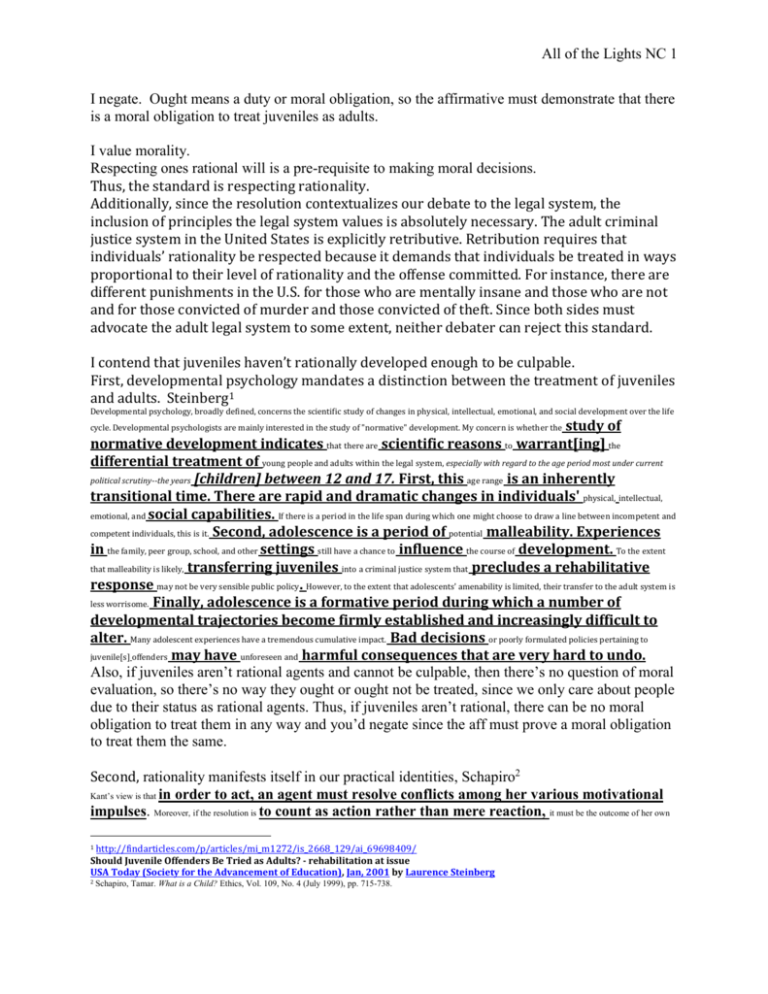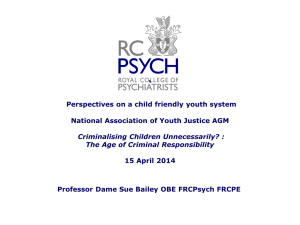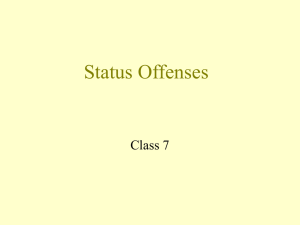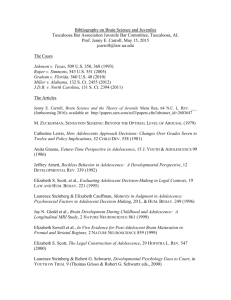All of the lights nc
advertisement

All of the Lights NC 1 I negate. Ought means a duty or moral obligation, so the affirmative must demonstrate that there is a moral obligation to treat juveniles as adults. I value morality. Respecting ones rational will is a pre-requisite to making moral decisions. Thus, the standard is respecting rationality. Additionally, since the resolution contextualizes our debate to the legal system, the inclusion of principles the legal system values is absolutely necessary. The adult criminal justice system in the United States is explicitly retributive. Retribution requires that individuals’ rationality be respected because it demands that individuals be treated in ways proportional to their level of rationality and the offense committed. For instance, there are different punishments in the U.S. for those who are mentally insane and those who are not and for those convicted of murder and those convicted of theft. Since both sides must advocate the adult legal system to some extent, neither debater can reject this standard. I contend that juveniles haven’t rationally developed enough to be culpable. First, developmental psychology mandates a distinction between the treatment of juveniles and adults. Steinberg1 Developmental psychology, broadly defined, concerns the scientific study of changes in physical, intellectual, emotional, and social development over the life study of normative development indicates that there are scientific reasons to warrant[ing] the differential treatment of young people and adults within the legal system, especially with regard to the age period most under current political scrutiny--the years [children] between 12 and 17. First, this age range is an inherently transitional time. There are rapid and dramatic changes in individuals' physical, intellectual, emotional, and social capabilities. If there is a period in the life span during which one might choose to draw a line between incompetent and competent individuals, this is it. Second, adolescence is a period of potential malleability. Experiences in the family, peer group, school, and other settings still have a chance to influence the course of development. To the extent that malleability is likely, transferring juveniles into a criminal justice system that precludes a rehabilitative response may not be very sensible public policy. However, to the extent that adolescents' amenability is limited, their transfer to the adult system is less worrisome. Finally, adolescence is a formative period during which a number of developmental trajectories become firmly established and increasingly difficult to alter. Many adolescent experiences have a tremendous cumulative impact. Bad decisions or poorly formulated policies pertaining to juvenile[s] offenders may have unforeseen and harmful consequences that are very hard to undo. Also, if juveniles aren’t rational agents and cannot be culpable, then there’s no question of moral evaluation, so there’s no way they ought or ought not be treated, since we only care about people due to their status as rational agents. Thus, if juveniles aren’t rational, there can be no moral obligation to treat them in any way and you’d negate since the aff must prove a moral obligation to treat them the same. cycle. Developmental psychologists are mainly interested in the study of "normative" development. My concern is whether the Second, rationality manifests itself in our practical identities, Schapiro2 Kant’s view is that in order to act, an agent must resolve conflicts among her various motivational impulses. Moreover, if the resolution is to count as action rather than mere reaction, it must be the outcome of her own http://findarticles.com/p/articles/mi_m1272/is_2668_129/ai_69698409/ Should Juvenile Offenders Be Tried as Adults? - rehabilitation at issue USA Today (Society for the Advancement of Education), Jan, 2001 by Laurence Steinberg 1 2 Schapiro, Tamar. What is a Child? Ethics, Vol. 109, No. 4 (July 1999), pp. 715-738. All of the Lights NC 2 deliberative activity. It must express her will, her capacity for reflective choice. Now in order for a motivational conflict even to appear to an agent as something resolvable through deliberation, the agent has to take it to have a certain significance. It cannot appear to her as a mere clash of unintelligible pushes and pulls. If that were the case, the appropriate response would be simply to wait and see which impulse wins out. Motivational conflict, if it is to be an occasion for deliberation, must appear to the agent [but rather] as a conflict between rival (though perhaps not fully articulated) claims. This means that the agent must take herself to be addressed by her impulses, conceived as claims. She must, in other words, regard her impulses as bidding her to do this or that —inviting her to do this or that on the implicit ground that it would be good for her to do so. These claims [that] purport to have a certain authority, the authority to make the agent herself —the one addressed by since the agent is reflective, that authority can come only from her own reason; autonomy is the source of obligation. If this is so, then the authority the conflicting claims purport to have is the authority of the agent herself; each presents itself as conforming to the law of her will. This sets up her task as an agent. Her task is to determine which claims really do conform to the law of her will and to render a verdict which actually gives those claims the normative force they purport to have. Notice, though, that she can fulfill this task only if the law of her will is already in effect. Judges cannot act as the claims —act accordingly. But Kant holds that judges without an authoritative set of laws to refer to It is this practical fact which provides the basis for a distinction between developed and undeveloped agents. In . the developed human being is one whose volitional laws are already in force. The adult, qua adult, is already governed by a constitution, so to speak —a unified, regulative perspective which counts as the expression of her will —and this makes it possible for her to live up to the demands of the judicial role which the practical point of view imposes upon her. An adult, in other line with Kant’s claim that only developed human beings are in a position to give themselves reasons of their own, we might say that words, is one who is in a position to speak in her own voice, the voice of one who stands in a determinate, authoritative relation to the various motivational forces childhood is a predicament. The immediate problem is that, like the pre-political society, the immature agent has to adjudicate her conflicting motivational claims on the basis of something like principle; because she is reflective, being a wanton is not an option. But she cannot adjudicate those conflicts in a truly authoritative way for lack of an established constitution, that is, a principled perspective which would count as the law of her will. Thus the condition of childhood is one in which the agent is not yet in a position to speak within her. This helps us to see the sense in which in her own voice because there is no voice which counts as hers. This, I take it, is the sense in which the undeveloped agent, unlike the developed agent, is unable to work out a plan of life ‘‘all at once.’’ Let me be clear about what I am not saying here. I am not saying that in order to be a developed agent one has to have worked there is a limited domain of essential questions, the answers to which determine the agent’s ‘‘basic structure.’’ 33 In Rawls, the subject matter of justice is the basic structure of society, where this notion refers to the way in which the major political, legal, out principles for dealing with every possible practical matter which might come up. Following Rawls again, it seems reasonable to claim that economic, and social institutions are organized with respect to one another. The idea is that it is the arrangement of these institutions which most fundamentally determines ‘‘where we stand with one another’’ as citizens, what the character of our political order is. The analogous idea in the intrapersonal case would be that the requisite critical perspective must organize the fundamental constituents of the agent’s motivational world. It must give her a ‘‘basic structure’’ as a person. This basic structure [that] would have to determine, for example, where the impulse to pursue desired objects stands relative to the impulse to relate to others on mutually acceptable terms. Juveniles do not have a basic structure against which to test actions and thus qualify as undeveloped moral agents., Steinberg3 The emergence of personal identity is an important developmental task of adolescence and one in which the aspects of psychosocial in many empirical tests of the process of identity formation Erikson’s (1968) theory of the adolescent identity crisis, includes considerable exploration and experimentation over the course of adolescence (Steinberg, 2002a). Although the identity crisis may occur in middle adolescence, the resolution of the crisis, with the does not occur until late adolescence coherent integration of the various retained elements of identity into a developed self, or early adulthood (Waterman, 1982). Often this experimentation involves risky, illegal, or dangerous activities like alcohol use, drug use, unsafe sex, and antisocial behavior. For most teens, these behaviors are fleeting; they cease with maturity as individual identity becomes settled. Only a relatively small proportion of adolescents who experiment in risky or illegal activities develop entrenched patterns of problem behavior that persist into adulthood (Farrington, 1986; Moffitt, 1993). Thus, making predictions about the development of relatively more permanent and enduring traits on the basis of patterns of risky behavior observed in adolescence is an until late adolescence, individuals’ values, attitudes, beliefs, and plans are likely to be tentative and exploratory rather than enduring representations of personhood. Thus, research on identity uncertain[.] business. At least development in adolescence supports the view that much youth crime stems from normative experimentation with risky behavior and not from deep-seated moral . deficiency reflective of “bad” character One reason the typical delinquent youth does not grow up to be an adult criminal is that the developmentally linked values and preferences that drive his or her criminal choices as a teenager change in predictable ways as the youth matures. The distinction between youthful criminal behavior that is attributable to characteristics that adolescents outgrow and conduct that is attributable to relatively more permanent elements of personality is captured in Moffitt’s (1993) work on the developmental trajectories of antisocial behavior. In her view, adolescent offenders fall into one of two broad categories: adolescencelimited offenders, whose antisocial behavior begins and ends during adolescence, and a much smaller group of life-course-persistent offenders, whose antisocial behavior begins in childhood and continues through adolescence and into adulthood. According to Moffitt, the criminal activity of both groups during adolescence is similar, but the underlying causes of their behavior are very different. Life-course-persistent offenders show longstanding patterns of antisocial behavior that appear to 3 Steinberg, Laurence [Professor of Psychology, Temple University; Director of John D. & Catherine T. MacArthur Foundation Research Network on Adolescent Development and Juvenile Justice] and Elizabeth S. Scott [Professor of Law, University of Virginia School of Law]. Less Guilty by Reason of Adolescence: Developmental Immaturity, Diminished Responsibility, and the Juvenile Death Penalty. December 2003. American Psychologist. Copyright American Psychological Association, Vol. 58, No. 12, 1009–1018. All of the Lights NC 3 be rooted, at least in part, in relatively stable psychological attributes that are present early in development and that are attributable to deficient socialization or Adolescence-limited offending, in contrast, is the product of forces that an inherent features of adolescence as a developmental period, including peer pressure, experimentation with risk, and demonstrations of bravado aimed at enhancing one’s status in the social hierarchy of the peer group. By definition, the causes of adolescence-limited offending weaken as individuals mature into adulthood. In view of what we know about identity development, it seems likely that the criminal conduct of most young wrongdoers is quite different from that of typical adult criminals. Most adults who engage in criminal conduct act on subjectively defined preferences and values, and their choices can fairly be charged to deficient moral character. This cannot be said of typical juvenile actors, whose behaviors are more likely to be shaped by developmental forces that are constitutive of adolescence. To be sure, some adolescents may be in the early stages of neurobiological anomalies. developing a criminal identity and reprehensible moral character traits, but most are not. Indeed, studies of criminal careers indicate that the vast majority of Thus adolescents who engage in criminal or delinquent behavior desist from crime as they mature into adulthood (Farrington, 1986). the criminal choices of typical young offenders differ from those of adults not only because the choice, is deficient as the product of immature judgment, but also because the adolescent’s criminal act does not express the actor’s bad character. The notion that individuals are less blameworthy when their crimes are out of character is significant in qua choice, . A claim that an adult’s criminal act was out of character requires a demonstration that his or her established character is good. The criminal choice of the typical adolescent cannot be evaluated in this manner because the adolescent’s personal identity is in flux and his or her character whose crime is mitigated because it is out of character, adolescent offenders lack an important component of culpability – the connection between as bad act and a bad character. Thus, adolescence is a period wherein juveniles are developing their character, but their choices are not fully informed. So juvenile’s wills are not fully developed and as such, they are different than adults. assessing the culpability of typical young offenders. IN one sense, young wrongdoers are not like adults whose acts are less culpable on this ground All of the Lights NC 4 Frontline: Affirming means punishment, negating means treatment. Viewing the resolution as a question of whether rehabilitation or retribution should be prioritized when the values conflict gives the best division of ground. If we try to figure out whether applications of effects are of rehab or retribution, it becomes impossible to derive what ground is actually aff or neg. For example, the law can be motivated by health or the law might mandate health. Since there’s no way to divide that out, it must be evaluated merely as a question of which value should be prioritized when they conflict. And, the distinction between juvenile and criminal justice proceedings is that in the adult system, offenders are viewed as culpable and are punished, while in juvenile proceedings, they are viewed as needing treatment. 1) Cornell Law4 explains the distinction: “The main goal of the juvenile justice system is rehabilitation rather than punishment.” 2) This is the most predictable interp since it represents the current distinction in the US criminal justice system. Predictability is key to fairness since I need to be able to reasonably predict arguments to substantively engage them. 3) This is the most reciprocal interp since we both get access to only one method of treatment. If the aff could rehabilitate juveniles, then they could defend both treatment and punishment but I could only defend one. Reciprocity is key to fairness since we need an equal threshold for the ballot to have a fair chance of winning. 4 Cornell University Law School; http://topics.law.cornell.edu/wex/Juvenile_justice All of the Lights NC 5 Frontline: Developmental psychology important Answering the resolutional question should be determined by looking through a developmental lens. Steinberg5 Transferring a juvenile to criminal court has three sets of implications that lend themselves to a developmental analysis. First, transfer to adult court alters the legal [trial] process by which a minor is tried. Criminal court is based on an adversarial model, while juvenile court is based, at least in theory, on a more cooperative model. This difference in the climates of juvenile versus adult courts is significant because it is unclear at what age individuals have sufficient understanding of the ramifications of the adversarial process and the different vested interests of prosecutors, defense attorneys, and judges. Second, the legal standards applied in adult and juvenile courts are different. For example, competence to stand trial is presumed among adult defendants unless they suffer from a serious mental illness or substantial mental retardation . We do not know if the presumption of adjudicative competence holds for juveniles, who, even in the absence of mental retardation or mental illness, may lack sufficient competence to participate in the adjudicative process. Standards for judging culpability may be different in juvenile and adult courts as well. In the absence of mental illness or substantial deficiency, adults are presumed to be responsible for their own behavior. We do not know the extent to which this presumption applies to juveniles, or whether the validity of this presumption differs as a function of the juvenile’s age. Finally, the choice of trying a young offender in adult versus juvenile court determines the possible outcomes of the adjudication. In adult court, the outcome of being found guilty of a serious crime is nearly always some sort of punishment; about 80% of juveniles who are convicted in criminal court are the outcome of being found delinquent may be some sort of punishment, but juvenile courts typically retain the option of a rehabilitative disposition, in and of itself or in combination with some sort of punishment [unlike adult courts]. incarcerated. In juvenile court, http://www.northwestern.edu/ipr/jcpr/workingpapers/wpfiles/Steinberg_briefing.pdf Should Juvenile Offenders Be Tried As Adults? A Developmental Perspective on Changing Legal Policies Laurence Steinberg 55 All of the Lights NC 6 Frontline: Another reason why they aren’t psychologically culpable. Offenders under 16 aren’t rationally competent enough to understand the nature and effects of their actions. Steinberg6 There are numerous intellectual competencies that change during adolescence which are likely to underlie the development of adjudicative competence. Among them are [such as] the ability to engage in hypothetical and logical decision-making, to demonstrate reliable episodic memory, to extend thinking into the future (in order to envision the consequences of different pleas, to be able to take the perspective of others, and to understand and articulate one’s own motives and psychological state. Although these abilities emerge at somewhat different ages, it would be highly unlikely that an individual would satisfy all of these criteria much before the age of 12. At the other extreme, research suggests that the majority of individuals have these abilities by age 16. There is ample evidence, therefore, to raise concerns regarding the competence of adolescents under age 15 to participate in criminal trials. Although the a significant fraction of adolescents should not be assumed competent to protect their own interests in adversarial legal settings. If an adolescent does not have the understanding, appreciation, or reasoning ability necessary to make such decisions, criminal court is an inappropriate venue for determining that adolescent’s disposition. majority of 13-year-olds would likely meet the minimal competence criteria even at age 15, It is my view, therefore, that no youngster under the age of 13 should be tried in adult court. On the other hand, although more research is needed — and, as I noted earlier, this research is underway — it is likely that the majority of individuals older than 16 would satisfy the broader criteria for adjudicative competence. Individuals who are between the ages of 13 and 16 should be evaluated to determine their adjudicative competence before a waiver decision is made. http://www.northwestern.edu/ipr/jcpr/workingpapers/wpfiles/Steinberg_briefing.pdf Should Juvenile Offenders Be Tried As Adults? A Developmental Perspective on Changing Legal Policies Laurence Steinberg 66 All of the Lights NC 7 Frontline: Adolescents’ susceptibility to treatment is undeterminable, so assuming that adolescents are more susceptible to treatment is permissible. Steinberg7 Unfortunately, developmental research does not provide a satisfactory answer to these questions. Any judgment of amenability presumes not only individual malleability but at least some change in the juvenile’s environment. It is impossible to evaluate an individual’s amenability without considering the nature of the intervention to which the individual is going to be exposed and whether there is reason to believe that this particular intervention will be effective for this particular individual. Rather than make amenability judgments on the basis of an offender’s age, therefore, developmental research would indicate that such judgments should be made on the basis of the offender’s past experience. A youngster who has been exposed to certain types of interventions in the past and who has not responded to them effectively is relatively unlikely to respond to them in the future. Without such evidence, however, one would presume malleability in response to intervention. Overall, there is no basis in the developmental literature from which to draw generalizations about differences in amenability purely as a function of age. It is incorrect to suggest that there is an age below which individuals should remain treated as juveniles because they are especially likely to be amenable to change, but it is also incorrect to assume that there is an age beyond which individuals should be categorically assumed to be too hardened to be helped. Amenability decisions should be made on a case-by-case basis and should focus on the prior history, rather than the chronological age, of the offender. http://www.northwestern.edu/ipr/jcpr/workingpapers/wpfiles/Steinberg_briefing.pdf Should Juvenile Offenders Be Tried As Adults? A Developmental Perspective on Changing Legal Policies Laurence Steinberg 77









